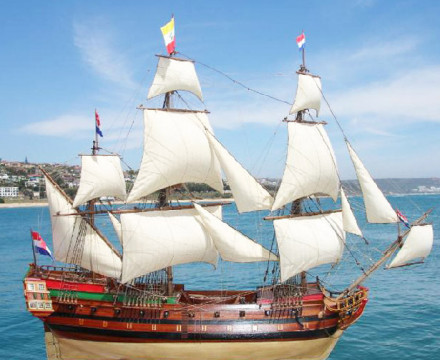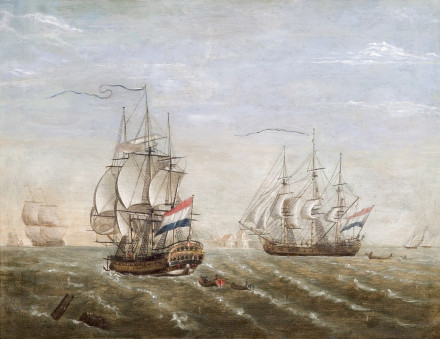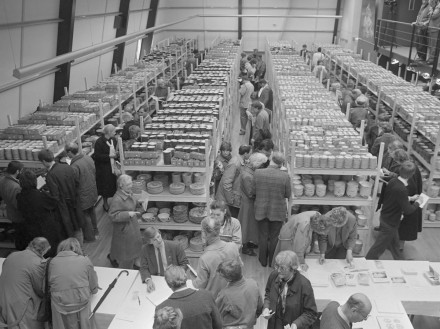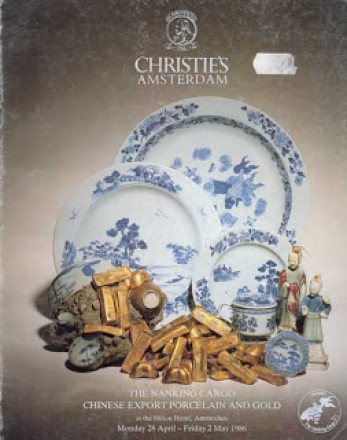History
The Dutch East India Company (VOC) ship Geldermalsen left the roads of Rammekens in Zeeland on August 16th 1748, for her first voyage to Asia. The ship had been built for the VOC chamber of Zeeland. One of the directors of the VOC, Jan van Borssele, named the ship after the town of Geldermalsen where his family owned several goods, amongst which was an estate called Castle Ravenstein.
The ship arrived in Batavia on March 31st 1749. She then sailed on to Dejima in Japan on 2 August 1749. On December 13th she returned to Batavia. The next voyage was to Canton (Guanzhou) in China. The VOC had a trading post there. Drom Canton, the Geldermalsen went to Suratte in northwestern India. After this the ship returned to Canton.
Return voyage to Europe
The Geldermalsen left Canton on December 18th 1751 to return to the Netherlands via Batavia. The cargo consisted of tea, linen, silk fabrics and 203 chests of porcelain. The chests held 171 complete sets of China and much loose wares such as tea and coffee cups, tea pots, milk jugs, plates, saucers and spitting pots. The ship also carried bars of gold with a value of 68.135 guilders.
The ship ran onto a reef to the southwest of the island of Batam on January 3, 1752 (called Geldria's Drought). The crew managed to get the ship off the reef. Unfortunately, they got stuck again and the damage turned out to be considerable. Both the main mast and the rudder were broken and the ship was taking in water. Yet the crew managed to get the ship afloat again.
Two sloops were put in the water and a few hours later, the Geldermalsen capsized and sunk. 80 crew men, among whom was the skipper, drowned. A week later, the 32 surviving crew members reached Batavia in the sloops. Bosun Christoffel van Dijk had the highest rank of these remaining crewmen and was severely questioned about the incident by the authorities in Batavia.
The losses for the VOC were large. The cargo, mostly tea (686.997 pounds), was valued at 714.963 guilders. Asides from the cargo and lost gold, the ship itself had a value of about 100.000 guilders.

Discovery
The wreck site of the Geldermalsen was discovered in 1985 by commercial salvage diver M. Hatcher. Hatcher was strongly criticised by heritage advocates because removal of the ship's valuable cargo took precedence over a serious archaeological investigation of the site. The wreck was destroyed in the process, and the recovered cargo was sold at Christie's in Amsterdam for over £10 million.
Description
Yard: VOC yard Zeeland
Armament: 24 and 2 bronze cannons

Painting of the Slot ter Hooge (a ship similar to the Geldermalsen) by Jan Voermans, ca. 1780.
| People on board | 300 |
|---|---|
| Length | 150 feet (45.7 m) |
| Width | 42 feet (12.8 m) |
| Tonnage | 1150 ton (575 last) |
Status
Discovery and salvage
The wreck site of the Geldermalsen was discovered in 1985 by commercial salvage diver M. Hatcher. Hatcher was strongly criticised by heritage professionals and archaeologists because the removal of the ship's valuable cargo took precedence over a serious archaeological investigation of the site. The wreck was destroyed in the process.

A porcelain treasure
Those salvaging the cargo were mostly interested in the over 150.000 pieces of porcelain that were on board, originating from the Jingdezhen region, which was often termed the ‘Porcelain Capital of China’.

The salvaged cargo was sold at Christie's in Amsterdam for over 10 million British Pounds. The New York Times wrote of the sale: 'An extraordinary sum and beyond the wildest expectations of Christie's and Max de Rham. A record for any similar sale in Holland, the 2nd highest from any Christie's auction to that time.'

Michael Hatcher donated some imported pieces of porcelain to the Groninger Museum and a number of artefacts were given to the Dutch state, who transferred them to the MuZeeum Maritime Museum.
References
- Nationaal archief.
Geldermalsen vergaat. - 1.11.01.01.551 Lijst van alle zoodanige Schepen.
- Jörg, C.J.A.
The Geldermalsen. History and porcelain.
Groningen, Kemper. - DAS 7371.1.